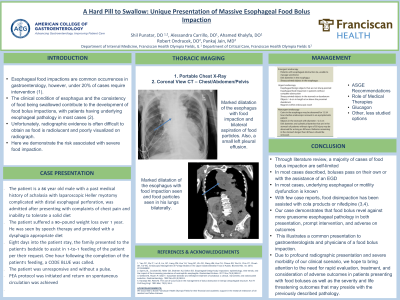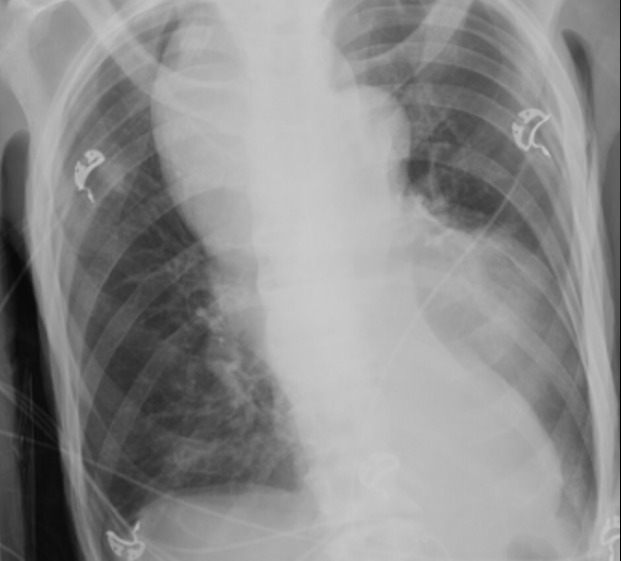Back

Poster Session B - Monday Morning
Category: Esophagus
B0258 - A Hard Pill to Swallow: Unique Presentation of Massive Esophageal Food Bolus Impaction
Monday, October 24, 2022
10:00 AM – 12:00 PM ET
Location: Crown Ballroom


Shil Punatar, DO
Franciscan Health Olympia Fields
Schaumburg, IL
Presenting Author(s)
Shil Punatar, DO1, Alessandra Carrillo, DO2, Ahamed Khalyfa, DO2, Robert Ondracek, DO3, Pankaj Jain, MD3
1Franciscan Health Olympia Fields, Olympia Fields, IL; 2Franciscan Health, Olympia Fields, IL; 3Franciscan Health, Chicago, IL
Introduction: Foreign body ingestion and esophageal food bolus impactions (EFBI) are common Gastroenterology emergencies, with an annual incidence of 13:100,000. While the vast majority of cases resolve on their own, about 10-20% of cases require endoscopic evaluation and disimpaction. In most cases, the composition of the food bolus, clinical condition of the esophagus, and underlying esophageal pathology contribute to the impaction. Imaging is usually difficult to obtain given the radiolucent nature of food. In this case, we encounter a presentation of esophageal food impaction that eventually contributes to the patient’s demise.
Case Description/Methods: An 86-year old male with a past medical history of achalasia complicated by small distal esophageal perforation status post laparoscopic Heller myotomy in 2013 was admitted after presenting with complaints of chest pain and an inability to tolerate a solid diet. On admission, the patient noted that he used to weigh approximately 180 lbs about a year ago compared to his admission weight of 90 lbs. Initial imaging in the ED showed an air-filled, dilated esophagus decreased in caliber from prior imaging. Eight days into the patient’s admission, his family presented to bedside to assist in 1-to-1 feeds at both the patient’s and family’s request. Thereafter, A CT chest following demonstrated a markedly dilated appearance of the patient’s esophagus with internal food material without a definite large obstructing lesion, markedly progressed from prior imaging. The patient was subsequently made NPO, transitioned to TPN, and plans were made for a follow-up disimpaction via EGD. The patient, however, was too unstable to undergo the procedure and expired 9 days after a cardiac arrest despite the efforts of a multidisciplinary team.
Discussion: Through literature review, a majority of cases of food bolus impaction are self limited. In the cases described, boluses pass on their own or with the assistance of an EGD. In most cases, underlying esophageal or motility dysfunction is known. We illustrate a common presentation to gastroenterologists and physicians of a food bolus impaction. Though, due to the profound radiographic presentation and severe morbidity of our clinical scenario, we hope to bring attention to the need for rapid evaluation, treatment, and consideration of adverse outcomes in patients presenting with food boluses as well as the severity and life-threatening outcomes that may preside with the previously trivially described pathology.

Disclosures:
Shil Punatar, DO1, Alessandra Carrillo, DO2, Ahamed Khalyfa, DO2, Robert Ondracek, DO3, Pankaj Jain, MD3. B0258 - A Hard Pill to Swallow: Unique Presentation of Massive Esophageal Food Bolus Impaction, ACG 2022 Annual Scientific Meeting Abstracts. Charlotte, NC: American College of Gastroenterology.
1Franciscan Health Olympia Fields, Olympia Fields, IL; 2Franciscan Health, Olympia Fields, IL; 3Franciscan Health, Chicago, IL
Introduction: Foreign body ingestion and esophageal food bolus impactions (EFBI) are common Gastroenterology emergencies, with an annual incidence of 13:100,000. While the vast majority of cases resolve on their own, about 10-20% of cases require endoscopic evaluation and disimpaction. In most cases, the composition of the food bolus, clinical condition of the esophagus, and underlying esophageal pathology contribute to the impaction. Imaging is usually difficult to obtain given the radiolucent nature of food. In this case, we encounter a presentation of esophageal food impaction that eventually contributes to the patient’s demise.
Case Description/Methods: An 86-year old male with a past medical history of achalasia complicated by small distal esophageal perforation status post laparoscopic Heller myotomy in 2013 was admitted after presenting with complaints of chest pain and an inability to tolerate a solid diet. On admission, the patient noted that he used to weigh approximately 180 lbs about a year ago compared to his admission weight of 90 lbs. Initial imaging in the ED showed an air-filled, dilated esophagus decreased in caliber from prior imaging. Eight days into the patient’s admission, his family presented to bedside to assist in 1-to-1 feeds at both the patient’s and family’s request. Thereafter, A CT chest following demonstrated a markedly dilated appearance of the patient’s esophagus with internal food material without a definite large obstructing lesion, markedly progressed from prior imaging. The patient was subsequently made NPO, transitioned to TPN, and plans were made for a follow-up disimpaction via EGD. The patient, however, was too unstable to undergo the procedure and expired 9 days after a cardiac arrest despite the efforts of a multidisciplinary team.
Discussion: Through literature review, a majority of cases of food bolus impaction are self limited. In the cases described, boluses pass on their own or with the assistance of an EGD. In most cases, underlying esophageal or motility dysfunction is known. We illustrate a common presentation to gastroenterologists and physicians of a food bolus impaction. Though, due to the profound radiographic presentation and severe morbidity of our clinical scenario, we hope to bring attention to the need for rapid evaluation, treatment, and consideration of adverse outcomes in patients presenting with food boluses as well as the severity and life-threatening outcomes that may preside with the previously trivially described pathology.

Figure: Manifestation of Esophageal Food Bolus Impaction on Initial Imaging
Disclosures:
Shil Punatar indicated no relevant financial relationships.
Alessandra Carrillo indicated no relevant financial relationships.
Ahamed Khalyfa indicated no relevant financial relationships.
Robert Ondracek indicated no relevant financial relationships.
Pankaj Jain indicated no relevant financial relationships.
Shil Punatar, DO1, Alessandra Carrillo, DO2, Ahamed Khalyfa, DO2, Robert Ondracek, DO3, Pankaj Jain, MD3. B0258 - A Hard Pill to Swallow: Unique Presentation of Massive Esophageal Food Bolus Impaction, ACG 2022 Annual Scientific Meeting Abstracts. Charlotte, NC: American College of Gastroenterology.
